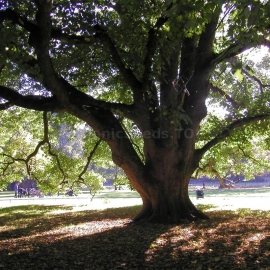






Organic Oriental Plane Seeds (Platanus orientalis)
1.14 €
The Oriental Planetree is a large, rounded and handsome shade tree. The cream coloured bark is quite attractive and is exfoliating. Its ornamental bark makes it an interesting specimen in a winter garden. A popular street tree.
-
Organic Oriental Plane (Platanus orientalis)
The Oriental Planetree is a large, rounded and handsome shade tree. The cream coloured bark is quite attractive and is exfoliating. Its ornamental bark makes it an interesting specimen in a winter garden. A popular street tree.
When choosing a location, keep in mind that the Oriental Planetree has a moderate to fast growth rate. It grows up to 90 feet in height and 60 feet in spread. It can be planted in zones 5 to 9. Prefers full sun or light shade and rich, moist, well-drained soil although is tolerant of less than ideal conditions.
Uses
Sycamore trees are often used to line streets and thoroughfares in urban areas. The tree is also used in residential settings and parks for shade and as a landscape plant. The wood is heavy and tough, but coarsely grained and difficult to work. It is sometimes used for butcher blocks, inexpensive furniture and crates.
Sycamore is Europe's largest maple, which can grow up to 25 plus metres. It can withstand salty winds and so is useful in coastal planting. A useful windbreak so is often seen in parts of Scotland especially around farmhouses. Propagation is easy using freshly picked seed. Maturing quickly, it can be felled for valuable timber within 60 years, but the life expectancy is near to 200 years. The sycamore is easy to work with and does not warp. Plants are shade tolerant at first but become light demanding in the post thicket stage. Introduced to Britain from Europe sometime during the Middle Ages, they spread rapidly and colonised new areas.
